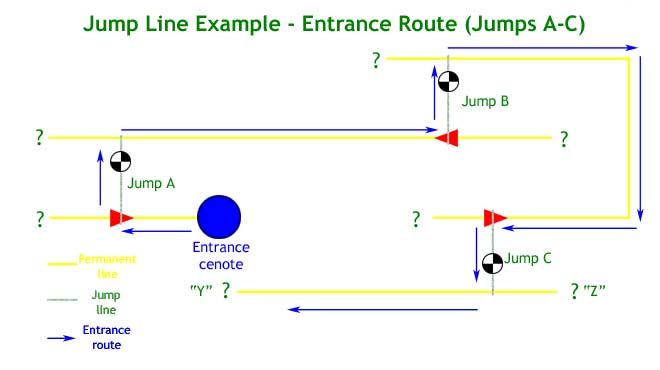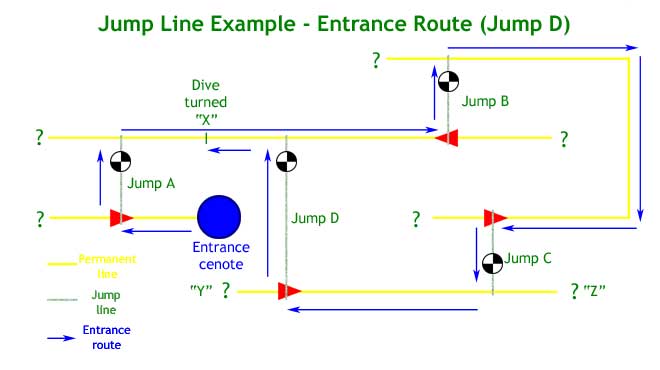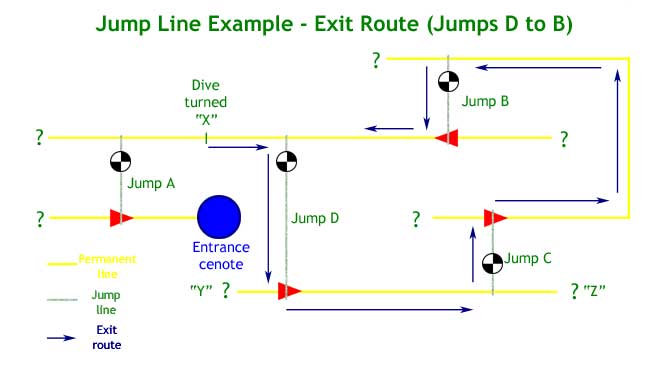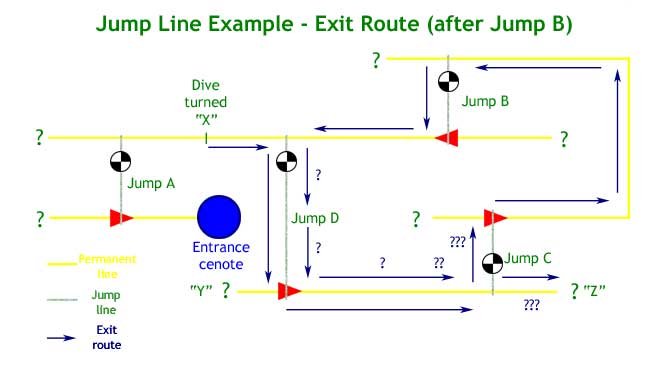
| Cave Formation | |||
| Training & Safety | |||
| Equipment | |||
| Projects | |||
| Papers | |||
| Photos | |||
| Video | |||
| Links | |||
| Contact Us | |||
Jump Line Example:
1. Having somehow survived the two previous dives, our explorers go diving again. This time they have little idea of the line layout, so the plan is take a number of jump spools and have a look around.
2. At each jump, they place a directional marker (arrow) pointing in the direction they came from, and run a jump line from this to the target permanent line. On reaching the permanent line, they tie off the jump line and spool.
3. From the entrance cenote, their initial route is as follows:

- from the main line they jump right at A to another line, where they turn right
- then they jump left at B, and turn right on the new line
- then they jump left at C and turn right on the new line.
4. Then they jump right at D and turn left on the new line:

5. At this point they are in fact back on a line they were on earlier, but they don't know it. In ignorance, they continue to point X, where they call the dive and begin an exit.
The Exit
1. Let us say that for some reason they decide to leave their jump lines in place - perhaps they want to come back and survey this mess of lines to find out where they have been. Or perhaps they get nervous about where they are and just want to get out quickly ...
2. They have learned their lesson from earlier dives, and they remember that they must follow four jump lines to exit, turning right once then left three times on these jumps, then left after the last jump..
3. The first right jump is on D and the next two left jumps are on C and B, all as they should be:

4. To exit from this point, they correctly remember that they must make one more jump to the left, turn left after the jump, and keep going. But the next jump line is in fact jump D, which they left in place. As this is going to the left, they take it:

5. At this stage they have no reason to know that they have gone wrong - everything has been exactly the reverse of how it was on the way in. When they get to the end of jump line D, they will follow the arrow thinking that they have just completed jump A and are heading out to the cenote. In fact they are heading into the cave.
6. Their first certain knowledge of a problem is when they reach the jump line at C instead of the entrance cenote. Now they know that something has gone wrong, because there should be no more jumps. Their options are to go back, go straight on, or follow the jump line to the left. Actually the most rational conclusion (at least in zero visibility) might be that this is not their jump line, so they will ignore it and go straight ahead ...
7. Going straight on at the jump will just take them further into the cave. Going back will not help them - there is really no directional information on this route. Following the jump won't help them for the same reason.
8. They might realise what might have happened and get clever - decide to follow the jump to the left, but now to take the jump lines out as they go. If they do this they will ultimately end up back at the same place, heading into the cave at Z, but now without jump lines B, C and D, i.e. with no continuous line to the exit.
Isn't this a Special Case?
1. This might look like a contrived case, and it is. It has been contrived to demonstrate that there are circumstances in which attempting to exit the cave leaving jump lines in place creates serious problems.
2. Even if it were an isolated theoretical example, it would be unsettling. But I don't think it is. I think that there are lots of cave systems with lines which are similar in layout to this example. For instance, almost any cenote with an upstream cave, a downstream cave, a bypass cave, and a few side branching passages on either the upstream or the downstream end will potentially be equivalent to the example ...
Back to cave conundrum or multiple T example.
Simon Richards, July 28, 2003
